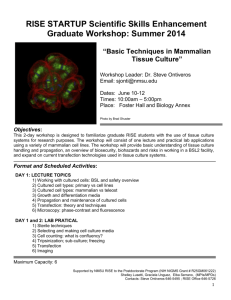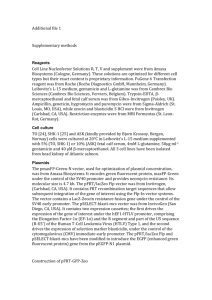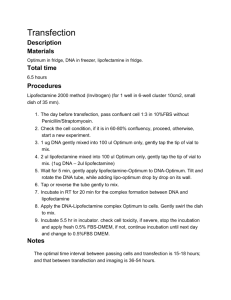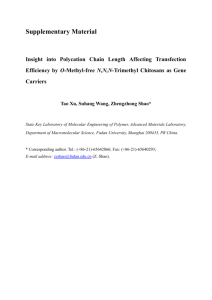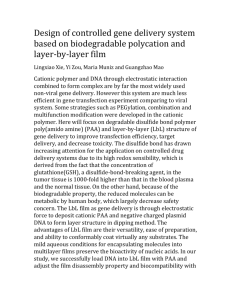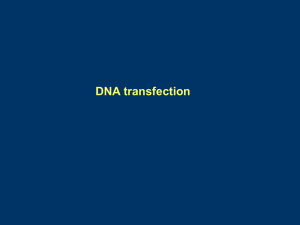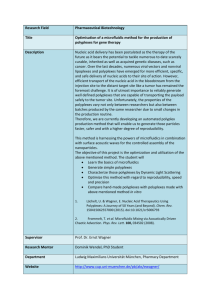XIANGXING ZHU, SHOUNENG QUAN, YONGLIAN ZENG, YONG
advertisement
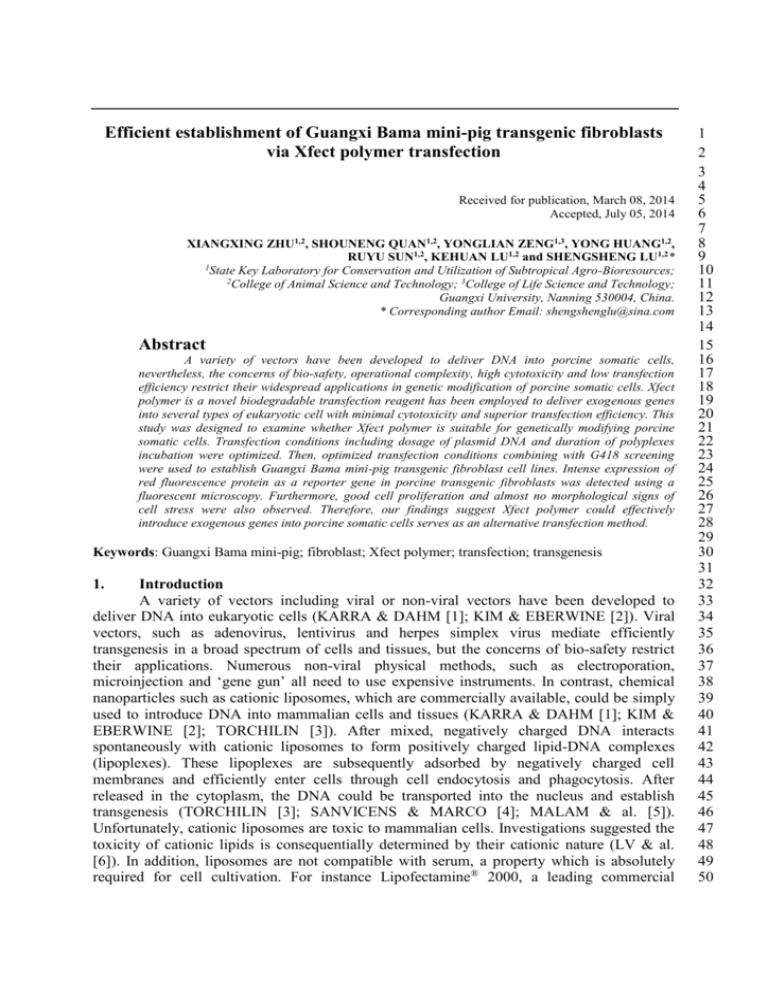
Efficient establishment of Guangxi Bama mini-pig transgenic fibroblasts via Xfect polymer transfection Received for publication, March 08, 2014 Accepted, July 05, 2014 XIANGXING ZHU1,2, SHOUNENG QUAN1,2, YONGLIAN ZENG1,3, YONG HUANG1,2, RUYU SUN1,2, KEHUAN LU1,2 and SHENGSHENG LU1,2* 1 State Key Laboratory for Conservation and Utilization of Subtropical Agro-Bioresources; 2 College of Animal Science and Technology; 3College of Life Science and Technology; Guangxi University, Nanning 530004, China. * Corresponding author Email: shengshenglu@sina.com Abstract A variety of vectors have been developed to deliver DNA into porcine somatic cells, nevertheless, the concerns of bio-safety, operational complexity, high cytotoxicity and low transfection efficiency restrict their widespread applications in genetic modification of porcine somatic cells. Xfect polymer is a novel biodegradable transfection reagent has been employed to deliver exogenous genes into several types of eukaryotic cell with minimal cytotoxicity and superior transfection efficiency. This study was designed to examine whether Xfect polymer is suitable for genetically modifying porcine somatic cells. Transfection conditions including dosage of plasmid DNA and duration of polyplexes incubation were optimized. Then, optimized transfection conditions combining with G418 screening were used to establish Guangxi Bama mini-pig transgenic fibroblast cell lines. Intense expression of red fluorescence protein as a reporter gene in porcine transgenic fibroblasts was detected using a fluorescent microscopy. Furthermore, good cell proliferation and almost no morphological signs of cell stress were also observed. Therefore, our findings suggest Xfect polymer could effectively introduce exogenous genes into porcine somatic cells serves as an alternative transfection method. Keywords: Guangxi Bama mini-pig; fibroblast; Xfect polymer; transfection; transgenesis 1. Introduction A variety of vectors including viral or non-viral vectors have been developed to deliver DNA into eukaryotic cells (KARRA & DAHM [1]; KIM & EBERWINE [2]). Viral vectors, such as adenovirus, lentivirus and herpes simplex virus mediate efficiently transgenesis in a broad spectrum of cells and tissues, but the concerns of bio-safety restrict their applications. Numerous non-viral physical methods, such as electroporation, microinjection and ‘gene gun’ all need to use expensive instruments. In contrast, chemical nanoparticles such as cationic liposomes, which are commercially available, could be simply used to introduce DNA into mammalian cells and tissues (KARRA & DAHM [1]; KIM & EBERWINE [2]; TORCHILIN [3]). After mixed, negatively charged DNA interacts spontaneously with cationic liposomes to form positively charged lipid-DNA complexes (lipoplexes). These lipoplexes are subsequently adsorbed by negatively charged cell membranes and efficiently enter cells through cell endocytosis and phagocytosis. After released in the cytoplasm, the DNA could be transported into the nucleus and establish transgenesis (TORCHILIN [3]; SANVICENS & MARCO [4]; MALAM & al. [5]). Unfortunately, cationic liposomes are toxic to mammalian cells. Investigations suggested the toxicity of cationic lipids is consequentially determined by their cationic nature (LV & al. [6]). In addition, liposomes are not compatible with serum, a property which is absolutely required for cell cultivation. For instance Lipofectamine® 2000, a leading commercial 1 2 3 4 5 6 7 8 9 10 11 12 13 14 15 16 17 18 19 20 21 22 23 24 25 26 27 28 29 30 31 32 33 34 35 36 37 38 39 40 41 42 43 44 45 46 47 48 49 50 product whose manufacturer suggest serum free medium such as Opti-MEM® should be utilized. This procedure will obviously increase the cost and labor. In an attempt to overcome those hurdles, recently, biodegradable polymer nanoparticles as novel non-viral vectors were developed (SANVICENS & MARCO [4]; MALAM & al.[5]; PANYAM & LABHASETWAR [7]). Unlike cationic liposomes are toxic to cells, biodegradable polymer nanoparticles are usually composed of synthetic or natural polymers, which could be hydrolyzed by cells into biologically compatible and metabolizable moieties (PANYAM & LABHASETWAR [7]). Biodegradable polymer nanoparticles are also cationic polymers can be similar to cationic liposomes combine with DNA to form nanoscale particulate complexes (polyplexes), and capable of gene transfer into cells. Furthermore, biodegradable polymer nanoparticles have the obvious advantage of compressing DNA molecules to a relatively small size, these may be favorable for improving transfection efficiency (SANVICENS & MARCO [4]; MALAM & al. [5]; PANYAM & LABHASETWAR [7]). In a recent work, Yang & al. [8] delivered DNA into human stem cells using biodegradable polymer nanoparticles with high efficiency and minimal cytotoxicity directly compared with Lipofectamine® 2000. Xfect polymer (Clontech, Palo Alto, USA) is an emerging product composed of biodegradable polymer nanoparticles. More convenient in operation, Xfect polymer employs a serum compatible protocol-no OptiMEM® is required. Owing to its unique advantages of simple, low cytotoxicity, high efficiency, and low cost, Xfect polymer has been already applied in several laboratories (GODIN & al. [9]; CAO & ZHANG [10]; WANG & al. [11]). Successful transfection involves ideal transfection efficiency and high survival rate of cells after transfection. These depend to a great extent on numerous factors such as DNA/reagent ratio, duration of polyplexes incubation and cell membrane conditions. Thus, it’s necessary to optimize the transfection conditions for a specific cell line. In the present study, one type of red fluorescent protein encoding plasmids (pDsRed2-N1; Clontech) used as a reporter gene in order to optimize the conditions of Xfect polymer transfection for genetic modification of porcine somatic cells. Then, optimized transfection conditions combining with G418 screening were used to establish Guangxi Bama mini-pig transgenic fibroblast cell lines. 2. Materials and Methods 2.1. Animal, reagents and medium One 1-2 days postnatal male Guangxi Bama mini-pig was obtained from a conservative farm of Guangxi Bama mini-pig located in Bama County of China. All animal procedures in this study were complied with the guidelines of the Institutional Animal Care and Use Committee (IACUC) of Guangxi University. Unless otherwise specified, all organic and inorganic reagents were purchased from Sigma-Aldrich Co. (St. Louis, MO, USA). All self-made media and solutions were filtered using a 0.22 µm filter (Millipore, Bedford, MA, USA) and stored at 4 or -20°C. 2.2. Isolation and cultivation of newborn Guangxi Bama mini-pig kidney fibroblasts The procedures used for isolation and cultivation of newborn Guangxi Bama mini-pig kidney fibroblasts were based on those described previously (LIU & al. [12]; LUO & al. [13]). After deeply anaesthetized, the piglet was euthanized and its bilateral kidneys were picked out and minced in Dulbecco’s phosphate buffered saline (DPBS; Gibco, Grand Island, NY, USA). Tissue fragments were washed several times with DPBS and digested in 0.25% (w/v) trypsinEDTA solution for 30 minutes at 37°C. Cell suspension was filtered using a 70 µm nylon cell strainer (BD Bioscience, Bedford, MA, USA) and pellets were collected by 1,000 rpm 51 52 53 54 55 56 57 58 59 60 61 62 63 64 65 66 67 68 69 70 71 72 73 74 75 76 77 78 79 80 81 82 83 84 85 86 87 88 89 90 91 92 93 94 95 96 97 98 centrifugation for 5 minutes. Cells were seeded onto 6-well cell culture cluster (Corning, NY, USA) in cell culture medium [Dulbecco’s modified Eagle medium (DMEM; Gibco) supplemented with 15% (v/v) newborn cattle serum (NBCS; Gibco), 66 µg/mL penicillin and 100 µg/mL streptomycin], then incubated at 37°C in a humidified atmosphere of 5% (v/v) CO2 in air. When achieved confluence, cells were harvested using 0.25% (w/v) trypsinEDTA solution digested for 3 minutes at 37°C, after centrifugation at 1,000 rpm for 5 minutes, cells were subcultured for 1-2 passages. For cryo-preserving, cells were harvested and re-suspended with freezing medium [a mixture of 70% (v/v) DMEM, 20% NBCS and 10% dimethylsulfoxide (DMSO)], then aliquotted into freezing tubes (Corning) and immersed in liquid nitrogen save standby. 2.3. Plasmid preparations Competent Escherichia coli cells transduced with pDsRed2N1 plasmid were seeded into LB medium (supplemented with 50 µg/ml kanamycin) and cultured with shaking overnight at 37°C. Plasmids were purified using an EndoFree Maxi Plasmid Kit (Tiangen, Beijing, China) according to the manufacturer’s instructions. The DNA concentration was estimated using a NanoDrop spectrophotometer (NanoDrop Technologies Inc., Washington, USA). Then, purified plasmids were kept at -20°C for future use. 2.4. Procedures of Xfect polymer transfection Before transfection, thawed fibroblasts were evenly seeded onto 3 wells of 6-well cell culture cluster, and cultured in antibiotics-free DMEM supplemented with 10% (v/v) NBCS until almost 50% confluence. Replaced the medium with fresh cell culture medium (antibiotics-free), then added polyplexes prepared in accordance with the design of transfection experiments. After a period of incubation, polyplexes were removed and added fresh cell culture medium (supplemented with antibiotics). At 24 hours post-transfection, cells were harvested for cell viability assay and 10% of each suspension were subcultured for an additional 24 hours, after which the transfection efficiency was measured. 2.5. Assays of cell survival rate and transfection efficiency Cell survival rate and transfection efficiency were used to evaluate the optimal conditions of Xfect polymer transfection. For survival rate assay, a trypan blue exclusion test was performed. At 24 hours post transfection, cells were harvested and stained with 0.4% (w/v) trypan blue solution. An inverted microscope (Nikon TS100, Tokyo, Japan) was used to detect the number of dead and live cells under visible light respectively. Survival rate (%) was calculated as the number of viable cells divided by the total number of cells. To avoid stable transgenesis confused by the presence of transient transfection, transfection efficiency was measured at 48 hours post transfection nearly let cells divided for two generations while the transiently transfected genetic materials will be lost during cell division. At 48 hours post transfection, cells were washed twice with DPBS and stained in DPBS containing 10 μg/ml of Hoechst 33342 for 10 minutes at room temperature. A fluorescence microscope (Nikon 50i) equipped with filter sets for blue and red fluorescence was used for microscopically analysis. Fluorescent micrographs were acquired using a NIS Elements image system (Nikon) and processed with Photoshop CS5 software (Adobe Systems Inc., San Jose, CA, USA). Transfection efficiency (%) was calculated as the number of cells with red fluorescence divided by the total number of cells labeled with blue fluorescence. 2.6. Design of Xfect polymer transfection experiments In consideration of the transfection reagent is valuable, the dosage of Xfect polymer reagent used in each experiment was fixed 1.5 µl according to the manufacturer’s recommendations. Transfection conditions 99 100 101 102 103 104 105 106 107 108 109 110 111 112 113 114 115 116 117 118 119 120 121 122 123 124 125 126 127 128 129 130 131 132 133 134 135 136 137 138 139 140 141 142 143 144 145 including dosage of plasmid DNA and duration of polyplexes incubation were optimized. All experiments were replicated for three times. 2.6.1. Different plasmid DNA dosage 2.5, 5.0 and 10.0 μg of pDsRed2-N1 plasmid DNA were diluted in each of 100 μl Xfect reaction buffers, and mixed thoroughly. Then 1.5 µl of Xfect polymer reagent was added into each of diluted DNA and incubated at room temperature for 10 minutes, after which the polyplexes were added into each of cell cultures. Duration of polyplexes incubation was fixed 4 hours and following steps were performed as described above. 2.6.2. Different duration of polyplexes incubation Optimal dosage of pDsRed2-N1 plasmid DNA was diluted with 100 μl Xfect reaction buffers in triplicate, and mixed thoroughly. Following steps were performed as described above excepted the duration of polyplexes incubation was varied at 4, 6 and 12 hours. 2.7. Establishment of Guangxi Bama mini-pig transgenic fibroblast cell line Once they had been optimized, optimal transfection conditions were used to establish Guangxi Bama mini-pig transgenic fibroblast cell line. At 24 hours post transfection, the transfected cells were split into 12 wells of 6-well cell culture clusters and cultured for an additional 24 hours. Then G418 was added into cell cultures at a final concentration of 600 µg/ml for resistance screening, performed for 7-10 days. The selection medium was changed every other day. Surviving cell colonies expressed red fluorescence were picked up and seeded onto one well of 12-well cell culture cluster in fresh medium supplemented with 300 µg/ml G418. When achieved confluence, cells were continuously expanding cultured for 2-3 passages till be froze in liquid nitrogen. Observation of the red fluorescence in these transgenic fibroblasts was performed as described above. 2.8. Statistical analysis Quantitative data were shown as mean ± standard deviation (SD), and errors bars represented the SD of the mean. Statistical analysis of the data was performed using SPSS 18.0 software (SPSS Inc., Chicago, IL, USA) by one-way ANOVA and DUNCAN test. A value of p < 0.05 was considered statistically significant. 3. Results 3.1. Influence of plasmid DNA dosage on transfection efficiency and cell survival rate Under fixed conditions of Xfect polymer dosage and duration of polyplexes incubation, varying plasmid DNA dosage had different influence on the expression rate of DsRed (Fig. 1A, 2A). The transfection efficiency was maximal as 9.4 ± 1.1% when the dosage of plasmid DNA was 5.0 µg, this result being significantly higher than that obtained in conditions with the dosage as 2.5 (9.4 ± 1.1% vs. 7.2 ± 0.2%, p < 0.05) and 10.0 µg (9.4 ± 1.1% vs. 3.4 ± 0.8%, p < 0.01). However, among all different conditions of plasmid DNA dosage, cell survival rate varied with no significant differences (97.8 ± 0.3%, 97.9 ± 0.9% and 97.5 ± 0.6% were respectively correlated with 2.5, 5.0 and 10.0 μg, p > 0.05; Fig. 2A). These results suggested under our laboratory conditions the optimal plasmid DNA dosage/Xfect polymer ratio was 5.0 µg/1.5 µl, which was used in subsequent experiments. 3.2. Influence of duration of polyplexes incubation on transfection efficiency and cell survival rate Fig. 1B and 2B show the transfection efficiency was influenced by duration of polyplexes incubation when the plasmid DNA dosage was fixed 5.0 µg. In spite of there was no significant difference when duration of polyplexes incubation varied from 4 to 6 hours (10.6 ± 0.9% vs. 10.9 ± 1.0%, p > 0.05), the transfection efficiency was significantly increased when the duration condition was extended to 12 hours (16.6 ± 0.6%, p < 0.01). Similar to the influence of plasmid DNA dosage on cell survival rate, extended duration of 146 147 148 149 150 151 152 153 154 155 156 157 158 159 160 161 162 163 164 165 166 167 168 169 170 171 172 173 174 175 176 177 178 179 180 181 182 183 184 185 186 187 188 189 190 191 192 193 polyplexes incubation didn’t affect the cellular viability (97.2 ± 0.7%, 96.3 ± 0.8% and 96.7 ± 0.9% were respectively correlated with 4, 6 and 12 hours, p > 0.05; Fig. 2B). These results suggested Xfect polymer was very friendly to porcine somatic cells, and extention of the duration of polyplexes incubation to 12 hours was beneficial to get an ideal transfection efficiency. 3.3. Establishment of Guangxi Bama mini-pig transgenic fibroblasts Optimized transfection conditions combining with G418 screening were used to establish Guangxi Bama mini-pig transgenic fibroblast cell line. After 7-10 days of resistance screening, intense red fluorescence emitted by surviving cell colonies was detected (Fig. 3A, A’). Furthermore, good cell proliferation and almost no morphological signs of cell stress were also observed from the transgenic fibroblasts which had been continuously expanding cultured for 2-3 passages (Fig. 3B, B’). 194 195 196 197 198 199 200 201 202 203 204 205 206 Fig. 1 Expression of DsRed by fibroblasts transfected using Xfect polymer. (A) Dosage of Xfect polymer and duration of polyplexes incubation were fixed 1.5 µl and 4 hours respectively, plasmid DNA dosage was varied at 2.5, 5.0 and 10.0 μg. (B) Dosage of Xfect polymer and plasmid DNA were fixed 1.5 µl and 5.0 μg respectively, duration of polyplexes incubation was varied at 4, 6 and 12 hours. Hoechst 33342 was employed to visualize nuclei, the co-localization of red and blue fluorescence indicated positive transgenic fibroblasts. (Scale bar = 100 µm) 207 208 209 210 211 212 213 214 215 Fig. 2 Influences of plasmid DNA dosage and duration of polyplexes incubation on transfection efficiency and cell survival rate. (A) Transfection efficiency was influenced by plasmid DNA dosage. Moderate dosage was corresponding to the maximum 216 217 218 219 efficiency (**, p < 0.01), while there’s no significant influence on cell survival rate (p > 0.05). (B) Transfection efficiency was influenced by duration of polyplexes incubation. The longest duration was corresponding to the maximum efficiency (**, p < 0.01), while there’s also no significant influence on cell survival rate (p > 0.05). All experiments were replicated for three times. Fig. 3 Guangxi Bama mini-pig transgenic fibroblasts emitted intense red fluorescence under the excitation of green light. Fluorescent micrographs of surviving cell clone suffered G418 resistance screening (A’) and transgenic fibroblasts (B’). A and B exhibit the bright pictures correspond to A’ and B’ respectively. (Scale bar = 100 µm) 4. Discussion Owing to the permeability of the cell membrane, large molecules such as DNA generally cannot be transported into cells. Thus, a carraier which can transport DNA across the membrane into cells is extremely required (KARRA & DAHM [1]; KIM & EBERWINE [2]). The most commonly used carriers are viral vectors, for instance adenovirus and lentivirus, which are unfortunately associated with bio-safety concerns. Non-viral vectors, such as liposomes offer an alternative, but they are often associated with high cytotoxicity, complex procedures as well as wide variations in transfection outcomes for different cell types. In general, according to the suggestion from KIM & EBERWINE [2], ideal method should have superior transfection efficiency, low cell toxicity, minimal effects on normal physiology as well as be easy to use and reproducible. Xfect polymer is a novel non-viral vector composed of biodegradable polymer nanoparticles, which could be innocuously catabolized by cells resulting in minimal cytotoxicity (PANYAM & LABHASETWAR [7]; YANG & al. [8]). Its properties of simple, low cytotoxicity and high efficiency have been already examined by several laboratories (GODIN & al. [9]; CAO & ZHANG [10]; WANG & al. [11]). The exact mechanism of how polyplexes pass through the cell membrane is unknown, but it is believed that endocytosis and phagocytosis are the main processes involved (KIM & EBERWINE [2]; TORCHILIN [3]; PANYAM & LABHASETWAR [7]; Yang & al. [8]). The positive charge on the surface of polymer generates an electrostatic interaction with nucleic acids and facilitates contact 220 221 222 223 224 225 226 227 228 229 230 231 232 233 234 235 236 237 238 239 240 241 242 243 244 245 246 247 248 249 250 251 with the negatively charged cell membrane. The initial interaction between polyplexes and cell membrane is electrostatic, hence the overall charge of the polyplexes is critical (KIM & EBERWINE [2]; TORCHILIN [3]; PANYAM & LABHASETWAR [7]). When fixed the Xfect polymer dosage, the overall charge will be determined by the dosage of plasmid DNA. Our results indicated as long as it didn’t offset the positive charge, the increase of DNA dosage was beneficial to improve transfection efficiency, while increase the DNA dosage further led to a decrease in resultant transfection efficiency. This study optimized DNA (µg): polymer (µl) ratio as 5:1.5 under our laboratory conditions. Duration of polyplexes incubation is another factor that deeply affects transfection efficiency. Our results indicated that extending the duration of polyplexes incubation was resulting in significant improvement of the transfection efficiency. This finding could be easily explained by the fact that the extension of duration of polyplexes incubation can increase the amount of polyplexes into cells via cellular uptake. To achieve expression of transgene, DNA must pass through the membrane into cells and reach the nucleus and become accessible to the transcriptional machinery (KARRA & DAHM [1]; KIM & EBERWINE [2]; TORCHILIN [3]; PANYAM & LABHASETWAR [7]). Due to the probability of exogenous gene integrated into the genome is extremely low, it’s indispensable to increase the amount of polyplexes into cells. In addition, we speculate that Xfect polymer is no cytotoxic and serum compatible, hence the cellular viability could most largely be kept. In this study, almost 100% of the cell survival rate was detected even when the duration of polyplexes incubation was extended to 12 hours, further indicating that an ideal transfection method is crucially needing to maintain optimal cellular activity. Optimal transfection conditions had employed to establish Guangxi Bama mini-pig transgenic fibroblast cell line, which exhibited high proliferation capacity and almost no morphological changes even suffered resistance screening for over a week. These findings suggested Xfect polymer could effectively introduce exogenous genes into porcine somatic cells and therefore serve as an alternative transfection method, which could be further used in a wide range field of life science research, for instance via somatic cell nuclear transfer (SCNT) to generate genetically modified pig models for biomedicine research (LIU & al. [14,15]; BAHR & WOLF, [16]; PRATHER & al. [17]). 5. Conclusions Our findings suggested that Xfect polymer could effectively introduce exogenous genes into porcine somatic cells and serve as an alternative transfection method. Under our laboratory conditions, the optimal plasmid DNA dosage/Xfect polymer ratio is 5.0 µg/1.5 µl, and the extend of polyplexes incubation duration to 12 hours is beneficial to get an ideal transfection efficiency. Acknowledgements We are very grateful to Dr. Tao Lin at Chungnam National University (Republic of Korea) for his generous advices. This study was supported by the National Natural Science Foundation of China (No. 31260553) and the Graduate Programs for Innovational Research founded by the Guangxi Provincial Department of Education (No. YCSZ2013003). Conflict of interest statement The authors declare no conflict of interest. References 252 253 254 255 256 257 258 259 260 261 262 263 264 265 266 267 268 269 270 271 272 273 274 275 276 277 278 279 280 281 282 283 284 285 286 287 288 289 290 291 292 293 294 295 296 297 298 1. 2. 3. 4. 5. 6. 7. 8. 9. 10. 11. 12. 13. 14. 15. 16. 17. D. KARRA, R. DAHM, Transfection techniques for neuronal cells. J. Neurosci., 30, 6171-6177 (2010). T.K. KIM, J.H. EBERWINE, Mammalian cell transfection: the present and the future. Anal. Bioanal. Chem., 397, 3173-3178 (2010). V.P. TORCHILIN, Recent advances with liposomes as pharmaceutical carriers. Nat. rev. drug discov., 4, 145-160 (2005). N. SANVICENS, M.P. MARCO, Multifunctional nanoparticles-properties and prospects for their use in human medicine. Trends Biotechnol., 26, 425-433 (2008). Y, MALAM, M. LOIZIDOU, A.M. SEIFALIAN, Liposomes and nanoparticles: nanosized vehicles for drug delivery in cancer. Trends Pharmacol. Sci., 30, 592-599 (2009). H.T. LV, S.B. ZHANG, B. WANG, S.H. CUI, J. YAN, Toxicity of cationic lipids and cationic polymers in gene delivery. J. Control. Release, 114, 100-109 (2006). J. PANYAM, V. LABHASETWAR, Biodegradable nanoparticles for drug and gene delivery to cells and tissue. Adv. Drug Deliver. Rev., 64, 61-71 (2012). F. YANG, S.W. CHO, S.M. SON, S.R. BOGATYREV, D. SINGH, J.J. GREEN, Y. MEI, S. PARK, S.H. BHANG, B.S. KIM, R. LANGER, D.G. ANDERSON, Genetic engineering of human stem cells for enhanced angiogenesis using biodegradable polymeric nanoparticles. Proc. Natl. Acad. Sci. USA, 107, 3317-3322 (2010). L.M. GODIN, J. VERGEN, Y.S. PRAKASH, R.E. PAGANO, R.D. HUBMAYR, Spatiotemporal dynamics of actin remodeling and endomembrane trafficking in alveolar epithelial type I cell wound healing. Am. J. Physiol. Lung. Cell. Mol. Physiol., 300, 615-623 (2011). J.Z. CAO, X.M. ZHANG, Comparative in vivo analysis of the nsp15 endoribonuclease of murine, porcine and severe acute respiratory syndrome coronaviruses. Virus Res., 167, 247-258 (2012). M.X. WANG, Z.Y. GUO, S.L. WANG, Regulation of cystathionine γ-lyase in mammalian cells by hypoxia. Biochem. Genet., 52, 29-37 (2013). H.B. LIU, P.R. LV, X.G. YANG, X.E. QIN, D.Y. PI, Y.Q LU, K.H. LU, S.S. LU, D.S. LI, Fibroblasts from the new-born male testicle of Guangxi Bama mini-pig (Sus scrofa) can support nuclear transferred embryo development in vitro. Zygote, 17, 147-156 (2009). J. LUO, M.M. LIANG, X.G. YANG, H.Y. XU, D.S. SHI, S.S. LU, Establishment and biological characteristics comparison of Chinese swamp buffalo (Bubalus bubalis) fibroblast cell lines. In Vitro Cell. Dev. Biol. -Animal, 50, 7-15 (2014). H.B. LIU, P.R. LV, R.G. HE, X.G. YANG, X.E. QIN, T.B. PAN, G.Y. HUANG, M.R. HUANG, Y.Q. LU, S.S. LU, D.S. LI, K.H. LU, Cloned Guangxi Bama minipig (Sus scrofa) and its offspring have normal reproductive performance. Cell. Reprogram., 12, 543-550 (2010). H.B. LIU, P.R. LV, X.X. ZHU, X.W. WANG, X.G. YANG, E.W. ZUO, Y.Q. LU, S.S. LU, K.H. LU, In vitro development of porcine transgenic nuclear-transferred embryos derived from new-born Guangxi Bama mini-pig kidney fibroblasts. In Vitro Cell. Dev. Biol. -Animal, in press, doi: 10.1007/s11626-0149776-8 (2014). A. BAHR, E. WOLF, Domestic animal models for biomedical research. Reprod. Dom. Anim., 47 (Suppl. 4) 59-71 (2012). R.S. PRATHER, M. LORSON, J.W. ROSS, J.J. WHYTE, E. WALTERS, Genetically engineered pig models for human diseases. Annu. Rev. Anim. Biosci., 1, 203-219 (2013). 299 300 301 302 303 304 305 306 307 308 309 310 311 312 313 314 315 316 317 318 319 320 321 322 323 324 325 326 327 328 329 330 331 332 333 334 335 336 337 338 339

